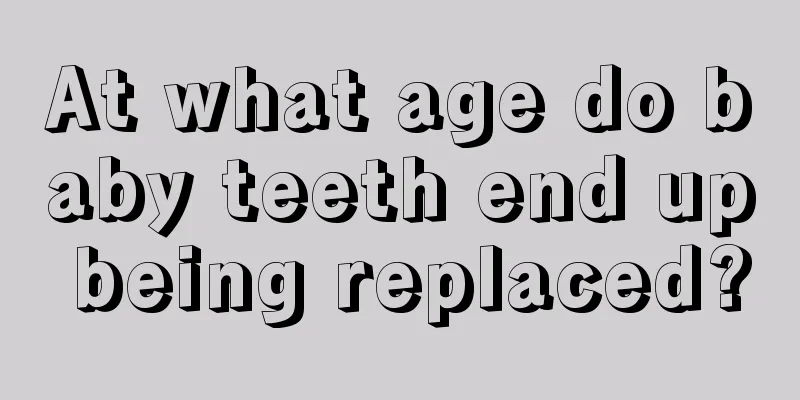At what age do baby teeth end up being replaced?

|
Most children will start to change their teeth around the age of 6, and generally follow a fixed order when changing their teeth. If during this period, they fail to pay good attention to oral hygiene and effectively protect their teeth, they may suffer from tooth decay or even tooth deformities. Let us now understand the order and precautions of children's tooth replacement. A person grows teeth twice in his life, once is the deciduous teeth, and once is the permanent teeth, which are adult teeth. The permanent tooth germs begin to develop and calcify after birth and start to erupt at the age of 6-7. There are 32 permanent teeth in total, and they are usually fully erupted by the age of 20. When the permanent teeth erupt, the deciduous teeth fall out one after another, and the time sequence is as follows: At the age of 6, the two lower incisors come out, and at the same time, the first large molars, commonly known as molars, come out behind the second deciduous molars, one on the upper and lower left and right; the two lower deciduous incisors fall off. At the age of 7, the two upper front teeth came out and the two deciduous front teeth fell out. At the age of 8, the upper and lower incisors come out, and the upper and lower deciduous incisors fall out. At the age of 9-10 years, the lower canines and the first bicuspids (one on each side, upper and lower) break out, and the lower deciduous canines and the first deciduous molars (one on each side, upper and lower) fall off. At the age of 10 to 11 years, the upper canines emerge and the upper deciduous canines fall out (one on each side). At the age of 11 to 12, the upper and lower second canines come out (one on each side), and the upper and lower third deciduous molars fall off (one on each side). Generally, all the deciduous teeth fall out at the age of 12 to 13, and then only permanent teeth, namely molars, come out. The second molars come out at the age of 12, and the third molars come out at the age of 18, every 6 years, hence the name 6-year-old teeth. However, some people do not get these teeth until around 30 years old, and some individuals do not get them at all. When children are changing their teeth, if the deciduous teeth do not fall out and the permanent teeth erupt on the side of the deciduous gums, which is the so-called double teeth, they should go to the hospital as soon as possible to extract the deciduous teeth, and the permanent teeth can quickly return to their original positions. In addition, if the deciduous teeth fall out early and the permanent teeth do not erupt for a long time, children will be accustomed to chewing food with their gums, and the gums will become keratinized and thickened, making it difficult for the permanent teeth to erupt. If the permanent teeth are close to the gums and the gums become dark and white, and the hard cutting edge of the teeth is touched under the gums during palpation, the gums at the cutting edge can be cut off to expose the cutting edge of the teeth, which will accelerate the eruption of the teeth. In addition, children should eat more hard and crisp foods during the period of tooth replacement, such as steamed bread, dry bread, dry corn bread, vegetables, beans, etc., to stimulate the development of upper and lower jaws and promote the early eruption of permanent teeth. When deciduous teeth are lost, the roots are absorbed first. After the rootless deciduous tooth crown falls off, the permanent tooth crown will erupt from under the gums in the original tooth socket. For newly erupted teeth, the dentin has not yet fully formed and the root continues to develop. It takes about 11/2 to 3 years for the root apex to be fully formed. During the period of teething or tooth replacement, children must be well protected, avoid all trauma, and pay attention to nutrition, especially mineral salts, calcium, phosphorus, or vitamins D, A1, C, etc., to promote the formation and calcification of tooth hard tissue. During the period of tooth replacement, children can eat more calcium-rich foods and try to get some sun exposure to effectively enhance the body's synthesis of vitamin D, which can help the effective absorption of calcium and have a good effect on the development of teeth. You should also try to keep your mouth clean to reduce the growth of bacteria. |
<<: How to treat encephalitis in children
>>: Can you still grow taller after development?
Recommend
What should I do if my baby teeth are decayed?
Do you have cavities in your deciduous teeth? In ...
What to eat for children with iron deficiency anemia
Iron deficiency anemia is also a type of anemia. ...
What happened if the newborn baby hasn't pooped for 2 days?
9. Newborns sometimes do not have bowel movements...
How many degrees of fever should I take antipyretics
It is normal for the body to have a fever, but ma...
What to do if your child sprains his foot
Sprain is a common problem for adults. After a sp...
What are the causes of high blood sugar in children?
Blood sugar problems are not only a health proble...
Symptoms and treatment methods of mentally retarded children
There are more and more mentally retarded childre...
How to treat baby tooth decay?
Children do not take good care of their oral cavi...
Neonatal breast enlargement
Anyone who has been a parent knows that in the fi...
What department should I go to for my child's genital itching?
Children's genitals are very susceptible to i...
What medicine is effective for children with frequent urination
In today's society, there are not many childr...
Treatment of pharyngeal ulcers in children
Children's throat ulcers look very scary. Rec...
The baby sleeps from the afternoon to the next day
Sleep is very important for both adults and child...
What is the normal body temperature of a child?
Some children nowadays are in very unhealthy cond...
Infants with delayed swallowing function
In the eyes of many parents, children's abili...









